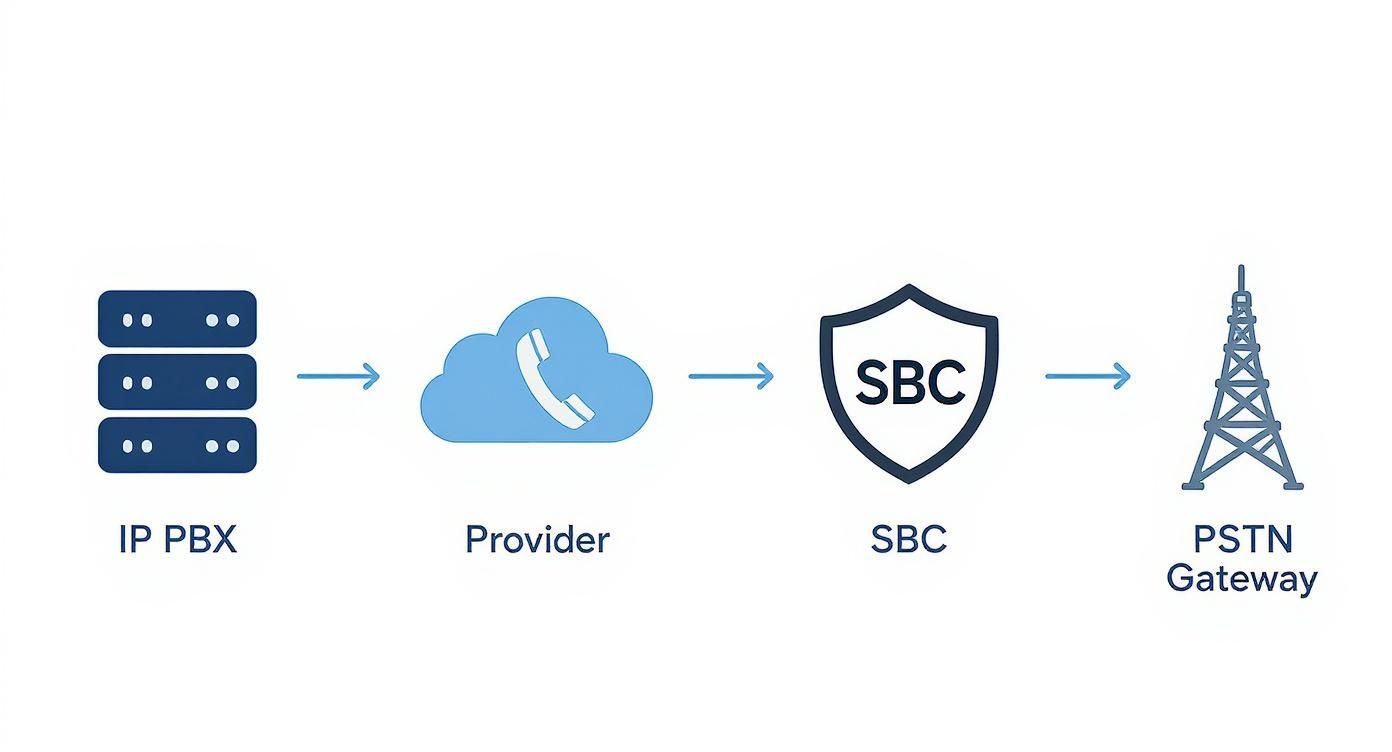Think of your business's phone system like a highway. For decades, we relied on old, single-lane roads—traditional phone lines made of physical copper wires. SIP trunks are the modern, multi-lane digital superhighway for your calls, running straight over your existing internet connection.
So, how do SIP trunks work? They are essentially virtual phone lines that use your internet connection to make and receive calls. This single change is a game-changer for any modern business, unlocking serious cost savings, incredible flexibility, and features that old-school systems just can't touch.
What SIP Trunks Are and Why They Matter

At its heart, Session Initiation Protocol (SIP) trunking is just a way to deliver phone service to your office over the internet. Instead of getting a bundle of physical copper wires from the phone company, a SIP trunk creates a direct, virtual link between your phone system and the Public Switched Telephone Network (PSTN)—the same network that connects all phone numbers.
This technology is the backbone of modern Voice over IP (VoIP) and Unified Communications. It combines multiple communication channels into a single "trunk," letting voice, video, and messages travel as simple data packets over the internet you already have. It's this shift that makes today's business communication so agile and powerful.
The Move Away from Physical Lines
The entire telecom industry is moving away from old ISDN and analog systems, with many countries planning to phase them out completely by 2025. This makes getting a handle on SIP trunking more important than ever. Companies that make the switch are already seeing a massive impact on their bottom line.
SIP trunking is more than just a technical upgrade; it's a strategic business move. By turning your phone lines into a virtual service, you gain a level of flexibility and control that is impossible with traditional, hardware-based systems.
This move from physical to virtual brings dramatic cost reductions. Studies show that businesses can slash their communication bills by 20% to 60% by switching to SIP. The savings come from getting rid of expensive PRI line rentals, cutting long-distance charges, and paying only for the exact number of phone lines you actually need. You can find a full breakdown of SIP trunking costs and its explosive market growth on einpresswire.com.
Building a Foundation for Modern Communication
SIP trunking isn’t just about replacing old phone lines; it's about building a solid foundation for a more connected and efficient way of working. Once your voice calls are running over your internet connection, you open the door to all the advanced tools that define a modern workplace.
These capabilities include:
- Unified Communications: Pulling voice calls, video meetings, team chat, and file sharing into a single, easy-to-use platform.
- Enhanced Mobility: Letting your team use their business phone number on any device, anywhere they have internet.
- Instant Scalability: Adding or removing phone channels whenever you need them through a simple web portal—no more waiting for a technician to install new lines.
This technology is a key piece of more advanced cloud-based phone systems. To see how it all fits together, check out our guide on what is UCaaS, which builds on the same principles as SIP trunking. Ultimately, understanding how SIP trunks work is the first step toward building a phone system that’s ready for whatever comes next.
Understanding the Core Components
To really get how SIP trunks work, you have to know the key players making every call happen. Think of it like a well-coordinated team—each member has a specific, vital role. If you take one piece out, the whole system just doesn't work.
We can break this team down into four core components. Seeing how they work together shows you just how powerful and elegant your business's modern phone service really is.
The IP PBX: Your Central Command Center
At the heart of your internal phone network is the IP Private Branch Exchange (IP PBX). This is the brain of your company's entire phone system. It's a software-based command center that manages all your office phones, handling call routing, voicemail, extensions, and other advanced features.
Imagine your office is a large building with dozens of internal phone lines. The IP PBX is your digital operator, switchboard, and directory all rolled into one. It knows where every phone is, manages call transfers between colleagues, and directs incoming calls to the right department—no human receptionist needed for every single call.
The SIP Trunk Provider: Your Digital Carrier
Next, you need a way to connect your internal command center to the outside world. That’s the job of the SIP Trunk Provider. They act as your digital-age telecom carrier, providing the virtual "highway" that links your business to the global Public Switched Telephone Network (PSTN).
Your provider is the bridge between your office's private phone system and every other phone number on the planet. When an employee dials an outside number, the IP PBX sends that call request to your SIP trunk provider, who then routes it over the internet and onto the traditional phone network.
The Session Border Controller: Your Network Security Guard
Standing at the edge of your network is the Session Border Controller (SBC), one of the most critical pieces for security and reliability. Think of the SBC as an intelligent security guard stationed at your network's front gate, inspecting all incoming and outgoing call traffic.
The SBC handles several crucial jobs:
- Security: It’s a specialized firewall for your voice traffic, protecting your system from threats like toll fraud and Denial of Service (DDoS) attacks.
- Compatibility: It helps different systems talk to each other by translating various "dialects" of SIP, making sure your PBX and your provider’s network are on the same page.
- Quality Control: It smooths out network issues that can block audio and helps prioritize voice data to keep your calls crystal clear.
An SBC is non-negotiable for any serious business deployment. It provides a robust layer of security and solves common network headaches that would otherwise disrupt your communications. Without it, your phone system is left vulnerable and unreliable.
The PSTN Gateway: Your On-Ramp to the World
Finally, there's the PSTN Gateway. While your SIP trunk provider handles much of this connection, the gateway is the specific technology that serves as the "on-ramp and off-ramp" between the digital and analog worlds.
When your VoIP call needs to connect to someone's old-school landline or mobile phone, it has to be converted from digital data packets back into an analog signal the traditional phone network understands. The PSTN Gateway handles this translation seamlessly in both directions, ensuring a call from your office computer can reliably ring a cell phone anywhere in the world. Together, these four components create a powerful, flexible, and secure communication system.
The Journey of a SIP Call Step by Step
To really get how SIP trunks work, it helps to follow a single call from the second you dial to the final "goodbye." It's an incredibly fast, complex dance that relies on two core protocols working together perfectly.
Think of it like a project manager and a delivery driver on the same team. One handles the planning and coordination, while the other handles the actual transport. This process happens millions of times a day, turning your voice into digital bits and zipping them across the internet to connect your business with the world.
The Two Stars of the Show: SIP and RTP
Every call has two main players. First up is the Session Initiation Protocol (SIP). SIP is the "call coordinator." Its job is to set up the call, manage it while you're talking, and tear it down when you're done. It's the brains of the whole operation.
Once SIP has connected the two parties, the second player takes the stage: the Real-time Transport Protocol (RTP). RTP is the "conversation carrier." Its only job is to carry the actual audio back and forth, making sure your conversation flows smoothly.
Let's break down how this team works together. This diagram shows the main components in play as a call travels from your office phone system to the global telephone network.

As you can see, the call starts at your internal IP PBX, goes through your SIP provider and a secure Session Border Controller (SBC), and finally breaks out to the traditional Public Switched Telephone Network (PSTN).
Step 1: SIP Initiates the Handshake
When you pick up your VoIP phone and dial, your IP PBX immediately sends out a SIP message called an "INVITE" through your SIP trunk provider. This digital message contains all the essential details about the call you want to make.
The INVITE message includes:
- The number you're trying to reach.
- Your own phone number.
- What kind of communication it is (like a voice call).
- The audio codecs your system can understand.
This is basically the digital version of asking, "Hey, is anyone at this number available for a chat?" The provider's network takes that message, finds the person you're calling, and forwards the invitation.
Step 2: The Connection is Accepted
The phone system on the other end receives the INVITE. If the person is available, their system sends back a series of SIP responses that essentially say, "Yep, I'm here and ready to talk." This entire exchange happens in the blink of an eye.
This SIP "handshake" is what establishes a stable connection. It's a critical moment where both systems agree on the technical rules for the call before any audio is sent.
During this negotiation, both phone systems also agree on which codec to use. This ensures both sides are speaking the same digital language, which is vital for clear audio. It's a key behind-the-scenes step that prevents garbled sound.
Step 3: RTP Delivers the Conversation
With the connection set up by SIP, RTP now takes over. Your voice is captured by the microphone, digitized, and compressed into tiny data packets by the agreed-upon codec. RTP then sends these packets across the internet to the other person.
At the same time, the person on the other end is doing the exact same thing. Their RTP packets travel back to you, where your phone decompresses them and turns them back into sound. This two-way, real-time exchange is what makes a conversation possible. A lot of network hiccups can mess with this flow; a common one is a router setting that gets in the way. You can learn more about how a feature called SIP ALG can affect call quality in our detailed guide.
Step 4: SIP Ends the Call
When you're done talking and hang up, your IP PBX sends one last SIP message: a "BYE" request. The other system acknowledges it, and SIP formally ends the session, freeing up the resources on both ends.
This step is just as important as the setup. A clean hang-up prevents "ghost calls" or stuck channels that can tie up your phone lines. From start to finish, this process shows how SIP and RTP work in tandem to deliver the reliable, high-quality business calls you depend on.
Ensuring Crystal-Clear Call Quality and Security
When you move your business phone system to the internet, a couple of big questions usually pop up. Will my calls sound clear all the time? And how safe is a phone call traveling over the same network as everything else?
The good news is, with the right setup, SIP trunking is both incredibly reliable and secure. It all boils down to getting four things right: bandwidth, network priority, security, and encryption. When these pieces are locked in, they create a solid foundation for high-quality, protected business communications.
Your Network's VIP Express Lane for Voice Calls
The first step to flawless call quality is simply having enough bandwidth. A single SIP call doesn't use much—about 85-100 kbps—but things add up fast. If you have a dozen people on the phone while others are in video meetings or using cloud apps, you need a connection that won't buckle under the pressure. That's where a high-speed fiber connection really shines.
But having a big internet "highway" isn't the whole story. You also need to manage the traffic. This is where Quality of Service (QoS) comes into play. Think of QoS as creating a dedicated, high-speed VIP express lane on your network just for your voice calls.
Your router's QoS settings tell the network to prioritize voice data packets over everything else. This is a huge deal because voice calls are extremely sensitive to delays.
- Jitter: When data packets arrive out of order, conversations get choppy and garbled.
- Packet Loss: If packets get dropped because of network congestion, whole words or parts of sentences can vanish.
- Latency: This is that awkward delay between someone speaking and being heard, causing you to talk over each other.
By putting your voice traffic in the express lane, QoS makes sure your conversations flow naturally, without the annoying glitches that plague poorly configured systems.
Your Frontline Defense Against Digital Threats
While call quality is what your customers hear, security is what keeps your business safe. The Session Border Controller (SBC) we mentioned earlier is your system’s security guard, standing at the edge of your network to inspect every call coming in or going out.
An SBC is basically a specialized firewall designed specifically for voice traffic. It keeps a close eye out for any suspicious activity and is your main defense against a host of threats. Protecting your system from Distributed Denial of Service (DDoS) attacks is essential, and an SBC is a key part of that defense.
An SBC isn't just a nice-to-have; it's a must-have for any secure business phone system. It stops common attacks like toll fraud, where hackers hijack your system to rack up thousands of dollars in unauthorized international calls.
Beyond just stopping attacks, the SBC also smooths out common network issues that can drop calls, ensuring a solid connection between your phone system and your provider.
Sealing Your Conversations with Encryption
The final piece of the puzzle is "sealing" your communications with encryption. Two protocols work hand-in-hand to lock things down, kind of like a secure envelope and the sealed letter inside.
-
Transport Layer Security (TLS): This protocol encrypts the SIP signaling—all the behind-the-scenes messages that set up, manage, and tear down a call. Think of TLS as the sealed, tamper-proof envelope that protects the call's instructions.
-
Secure Real-time Transport Protocol (SRTP): This encrypts the actual audio of your conversation. SRTP is the confidential letter inside the envelope, making sure that even if someone intercepted the data, they couldn't listen in.
When you use both TLS and SRTP, you create a completely private and protected channel for every call. From the moment you pick up the phone to the moment you hang up, your conversations are for your ears only.
How Premier Broadband Delivers Flawless SIP Trunking

Here's a simple truth about how SIP trunks work: your call quality is only as good as the internet connection it runs on. A slow or shaky connection is the number one cause of dropped calls, choppy audio, and painful delays. This is exactly where Premier Broadband’s 100% fiber network gives your business phone system an unbeatable edge.
Unlike old-school cable internet that often has sluggish upload speeds, our fiber network provides symmetrical speeds. This means your upload speed is just as blazing fast as your download. For voice calls, this is a total game-changer. Your side of the conversation gets sent out instantly, making sure the person on the other end hears you perfectly without any lag. That two-way performance is absolutely key for clear, professional conversations.
The Fiber Advantage for Voice Quality
Speed is just the start. Fiber technology brings two more critical benefits to the table that are essential for high-performance SIP trunking: incredibly low latency and rock-solid reliability.
-
Ultra-Low Latency: Ever experienced that awkward pause in a call where you end up talking over each other? That's high latency. Fiber optic cables move data at the speed of light, slashing that delay and making your calls feel immediate and natural.
-
Unmatched Reliability: Our fiber network is built tough. It’s far less prone to the interference and outages that constantly plague older copper networks. This means a more stable connection, ensuring your phone system is always ready for business when you and your customers need it most.
With Premier Broadband, your internet connection is more than just a utility—it's a strategic asset. It's about building a consistent, high-quality foundation to get the most out of modern voice technology.
We don't just hand you an internet connection; we deliver the complete infrastructure your business needs to confidently upgrade its phone system. Our team gets the demands of VoIP and makes sure your network is fine-tuned for voice traffic from day one.
By pairing our powerful fiber network with our business-grade VoIP phone solutions, we become a true partner in your communications. You get one trusted provider for both your connectivity and your calls, guaranteeing smooth performance and making everything simpler to manage.
Your Top SIP Trunking Questions, Answered
Alright, so we've gone through the nuts and bolts of the technology. But what does it all mean for your business day-to-day? Here, we'll tackle the most common questions we get, giving you straight answers so you know exactly what to expect.
We'll clear up any concerns about your existing phone hardware, figure out how many channels you’ll actually need, and discuss the kind of internet that’s essential for professional performance. Let’s get these final details sorted.
How Many SIP Channels Does My Business Need?
This is a great question. The number of channels you need has nothing to do with your employee count and everything to do with your peak number of simultaneous calls. A good rule of thumb for most offices is a 3:1 or 4:1 ratio of employees to channels. So, if you have a 30-person office, you’d probably want between 8 and 10 channels.
Of course, a call-heavy business like a contact center might need a 1:1 ratio. The real beauty of SIP is its flexibility. You can add or remove channels in an instant through a web portal as your needs change—no more waiting for a technician to come install new physical lines.
Can I Keep My Existing Phone Numbers?
Yes, you absolutely can. In almost every case, you can bring your current phone numbers with you through a process called Local Number Portability (LNP). When you sign up with a new provider, they handle the entire transfer from your old carrier.
The process is standardized and designed to be completely seamless. It means you keep your established business identity without any disruption. Your customers will just keep calling the same numbers they always have.
The ability to port existing numbers is a cornerstone of modern telecom. It removes one of the biggest historical barriers to switching providers, giving businesses the freedom to choose the best service without sacrificing their brand identity.
What Is the Difference Between SIP Trunking and Hosted PBX?
While both are VoIP phone solutions, they fit different needs. SIP trunking connects your existing on-premise phone system (your IP PBX) to the internet. With this setup, you continue to own and manage your own PBX hardware.
A Hosted PBX, sometimes called UCaaS, is a completely cloud-based service where the provider manages the entire phone system for you. SIP trunking is the perfect fit for businesses that have already invested in a PBX, while a Hosted PBX is for those who'd rather have a fully outsourced, maintenance-free solution.
Ready to build a more powerful and reliable communication system? The experts at Premier Broadband can design a SIP trunking solution powered by our 100% fiber network, ensuring crystal-clear call quality and unmatched performance. Contact us today to get started.




